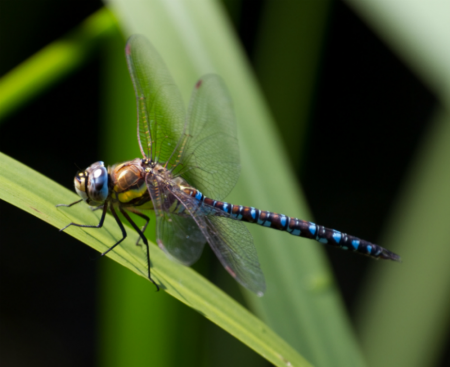Some flying insects may be considered menacing or frightening but others are also regarded as beautiful and interesting. Take, for example, certain flying insects such as the dragonfly and the damselfly.
There is something attractive about them. It may be because of their eye-catching colors or radiant wings. Although these are physical traits the dragonfly and damselfly have in common, they still have a lot of differences. Read on and we’ll tell you all about them and identify the specific attributes that set them apart.
Summary Table
| Dragonfly | Damselfly |
| Eyes almost touch at the top of their head | Eyes are clearly separated, appearing at the sides of the head |
| Body is stocky | Body is long and slender |
| Wings are not the same; hind wings broader at the base compared to front wings | Wing shapes are similar |
| When at rest, wings are held open horizontally or pointed downwards | When at rest, wings are held close above its abdomen |
Descriptions

A dragonfly belongs to the order Odonata, which means “toothed jaws.” It has three suborders and the dragonfly belongs to the suborder Anisoptera. There are more than 5,000 species of dragonflies and most of these live in tropical areas. The word “dragonfly” came from the Greek word anisos meaning “uneven” and pteron, meaning “wing.” The dragonfly has uneven wings, having a broader base on its hind wings compared to its front wings.
Physical traits
When you look closely at a dragonfly, you’ll notice that it has three segments: the head, the thorax (middle part), and the abdomen (segmented tail-like section). Dragonflies have a large head with short antennae and large eyes that almost touch each other and cover most of the head surface.
Another interesting thing about the dragonfly it that it has compound eyes which are efficient in scanning its surroundings. Each eye contains 28,000 lenses, enabling the insect to target its prey from 49 feet (15 meters) away. They also have razor sharp jaws that slice their prey.
Dragonflies have bright, metallic colors which make them easy to spot when in flight. They are noted to have powerful wing muscles and are regarded as strong, expert fliers. These insects can reach speeds of up to 35 mph (56 kph) and are often found flying near the water. They also have the ability to hover, fly off vertically, and even fly backwards – much like a helicopter. Their wings are either open horizontally or pointing downwards when at rest.
Dragonflies have a unique style of reproduction, often forming the “heart” posture. When mating, the male takes a grip of the back side of the female’s head (prothorax). Then the female curls her abdomen to get sperm from the male at the front side of his abdomen. Most dragonflies, especially the males, are very territorial and tend to defend their domain not only from other insects but also from their own species. Even at their larval stage (known as nymphs or naiads), dragonflies are known to be active predators. Since they eat mosquitoes, dragonflies are considered very helpful in controlling the population of the pests.

Damselflies also belong to the order Odonata but a different suborder, which is Zygoptera, which means “yoke-winged.” The damselfly’s front and hind wings are similar in shape and are usually placed together and are aligned with its abdomen when at rest.
Physical traits
The general body structure of a damselfly is similar to that of the dragonfly, with a head, thorax, and abdomen. However, the damselfly has a smaller body and more slender abdomen. Damselflies have large eyes, but they aren’t as big as dragonfly eyes.
Its eyes are separated, located at the sides of the head. The forehead is located above the eyes, and below it is the clypeus, which is a trapezoidal plate at the front of the head. On its upper lip you’ll find the labrum, which is an extendable organ used by the damselfly to capture its prey. The damselfly also has a tiny pair of antennae.
Damselflies are not super strong at flying. They often hover over grass and low vegetation.
Their spiny legs come in handy when picking prey off the stems and leaves. For the most part, they use their keen vision to locate their prey but may also use olfactory cues. Their diet usually consists of flies, mosquitoes, and other small insects.
Compared to females, male damselflies have more distinct, bright colors. They often have complex courtship behaviors. They reproduce by indirect insemination, forming the “heart” or “wheel” shape when they mate. The insects remain together with the male still holding on to the female as she lays her eggs among plants that are in or near the water.
Dragonfly vs Damselfly
So what is the difference between a dragonfly and a damselfly?
Though mostly similar in behavior and other characteristics, the dragonfly and damselfly differ in a lot of physical traits. The dragonfly has large eyes which almost touch each other at the top of its head while the damselfly has smaller eyes which are clearly separated, located at the sides of the head. The body of the dragonfly is stocky compared to the long and slender body of the damselfly. A dragonfly’s wings are not the same shape, with the base of the hind wings being broader than the front wings.
The damselfly’s wings, on the other hand, are similar in shape and size. When at rest, the dragonfly has its wings wide open horizontally or open and pointed downwards whereas the damselfly has its wings closed and placed above the abdomen.





